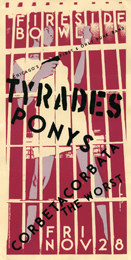Made in Chicago: David Head
By Jess D'Amico in Arts & Entertainment on Feb 1, 2008 8:10PM
 Made in Chicago has been buried under snow and soot for a minute, but on a cold, wintry day such as this, we're digging it out with another homemade gem to share with all of you to help you finish out the week.
Made in Chicago has been buried under snow and soot for a minute, but on a cold, wintry day such as this, we're digging it out with another homemade gem to share with all of you to help you finish out the week.
By day, David Head is a graphic designer for a local marketing firm, but by night, evidence of his indie posters and silkscreens (like this Pony's poster, right) can be seen in most Chicago venues, on indie CDs, or on the street. He also headlines Headache City, featured last September in a "This American Life" episode. Raised in San Antonio, Texas and Salt Lake City, Utah. David, 36, moved to Chicago nine years ago for design school, and is now a permanent Chicago art fixture.
David spoke with us about his collection of old design books, and why you shouldn't have listened to your teacher in high school.
Chicagoist: How do you make your art stand out from everything else out there?
David Head: I pay attention to what's going on [on design blogs], but when I'm consciously looking for inspiration, I hit the old art and design books. I mesh my awareness of what is going on with what was going on, so the end result is unique.
C: Where do you want to go with your work?
DH: In five years, I envision more illustration freelance work, silkscreen prints for high profile bands and media venues, silkscreen designs that have a place in the functional everyday realm, like my calendars. And art prints—just because. We [my biz partner, Jen Hazen and I] have so many ideas. Our to-do list is out of control and that's cool with us.
C: How did you start in your art?
DH: I drew and painted a lot as a kid. I had a bad art teacher in high school who convinced me I had no future in art. Don't listen to the naysayers!
In my late teens/early twenties I started playing in punk bands in Austin and designing flyers, zines, record covers, logos, t-shirts, stickers--whatever we needed. At the time, I worked at a huge university library and would disappear in the stacks—xeroxing images and typefaces, then sit at the reference desk cutting (with a knife) and pasting (with glue) to make these collages.
Eventually I became obsessed with graphic design and with art and design history, so no surprise that I ended up going to design school in Chicago. An old friend from Texas, amazing artist Keith Herzik, introduced me to Screwball Press, where I learned how to silkscreen print from the godfather of Chicago silkscreening, Steve Walters.
C: What does your process look like?
DH: At thrift stores, flea markets, used bookstores, in far-flung cities, taking photos or whatever, I collect visual objects that affect me—graphic ephemera, color palettes and patterns from fashion magazines, old art and design books, folk art, Mexican Novena pamphlets, records, signage, wallpaper….
When I begin a project, I sketch a lot until I have a good idea of what I want the piece to look like. I gravitate towards certain things I've collected and determine why they captivated me. I dissect that emotional draw, which gets me thinking about how to approach the creation of my own images. Then I create images (drawing, stenciling, collaging, lettering, etc.) and scan my work into my Mac, do some designing and make color separations for silkscreen printing.
What's the Chicago art scene look like?
DH: It's pretty. My experience as a participant is primarily in the art world subset of silkscreen printers. Generally, it's a very talented, supportive and friendly group. For example, Jen and I are curating an art show of silkscreen printers right now which will be hosted by the kind folks of Letterform Studio this spring. The participating silkscreen artists are all talented, humble, and genuinely passionate about their art. And that's contagious… to find others who live to create. They make me want to push myself further. The world is a more beautiful place when these people -- and others like them -- share their talents.
C: Where do you see that culture going?
DH: Once upon a time there was more of a distinction between the underground and the... not underground. The underground appropriated aspects of commercial art to its own ends. People on the fringe created their own media. I think the contemporary DIY movement is a reflection of a more general movement away from mass media. Now everyone wants their own media, or at least a media aimed at their particular market segment or whatever lifestyle "brand" they relate to.
Know somebody who should be featured here? Whisper in our ear: MadeinChicago[at]chicagoist[dot]com